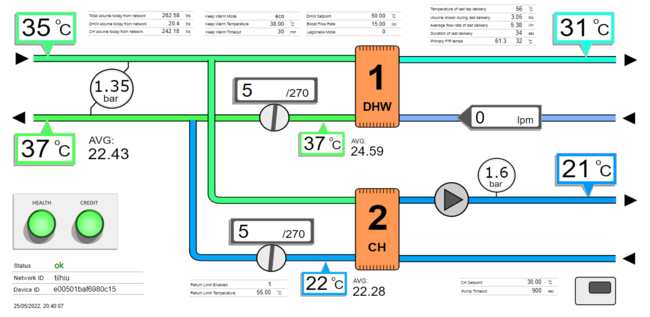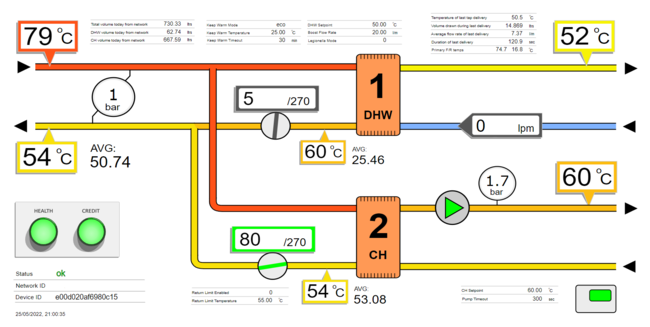HIU Monitoring and Controls Refurbishment
Graphics
Above is a live dashboard shows a twin plate HIU fitted with open-source monitoring (watch it and figures will change in real-time). If asked to login, use guest / guest.
This dashboard can be applied to any make of HIU where it is possible to extract data, either through wired connection or through the use of additional sensors.
This form of dashboard uses colours and text to give an 'at-a-glance' feeling for all temperatures and current operation. It includes sensor readings, settings read from the HIU, and daily statistics, while also providing access to graphs.
The two screenshots below show two systems in properties side by side. The one on the left is using compensated heating functions, and the one on the right is running a set central heating temperature. These HIUs are part of a field trial to understand the limits of return temperature performance that can be achieved with some more advanced HIU functionality. The key difference can be seen in the VWART (average return) figures on central heating of 22.26C and 53.08C respectively. Both systems are fitted with the same radiator systems, unbalanced with a 10C drop.
These systems can be seen running side by side live on the Dual HIU dashboard example.
The benefits of being able to test different settings and functions out on live systems in the field is of obvious advantage. With numerous systems in a development, it become much easier to optimise functionality than in a laboratory or R&D environment. The random element introduced by the real world shows up problems, and it is possible to run adjacent systems with different settings to compare outcomes.
In our many adventures in the field, where we come face to face with occupants, we have found that in every case (bar one) the occupants welcome some visibility on systems and are keen to see if improvements can be made. Occupants who suffer problems are all to aware that part of the problem can lie in engineers never been present to witness a problem, so having monitoring gives them evidence - even if they do not have access to data they are aware that you now do, and should be able to figure it out. Which you now can.
Graphs
Graphs are the other vital tool used in diagnostics, providing historical data that lets us understand events. The graph below shows central heating flow are return temperatures as well as room thermostat calls, from the system above with compensation. It allows us to analyse how the central heating is operating, and how often the room thermostat is calling. Once can see that in the morning, temperatures went up to over 50C, but as the room thermostat slows down its calls, the HIU drops supply temperatures to compensate. By mid-morning the system has settled into maintaining central heating with very little temperature input (it is a warm day). This is a rare graph as hot water use usually prevents temperatures from settling so low, but it provides the perfect example of how the real world performance of systems can be optimised remotely.


